tan
Dust clouds usually appear tan in VIIRS Cloud Phase RGB. Dust clouds are usually semi-transparent. Their actual colour shade depend both on the dust cloud properties and the characteristics of the background.
Dust detection is not the primary goal of Cloud Phase RGB, but the not too thin dust clouds are recognizable, especially over water. Dust clouds have different structure than ice and water clouds. They are smooth, blurred and have washed out colours.
In the following figures Cloud Phase RGB images are shown together with Dust and True Colour RGBs. This triple visualisation helps to confirm whether the blurred feature seen in Cloud Phase RGB is really dust cloud. Dust RGB was tuned especially for dust detection (based on IR channels), while True Colour RGB for aerosol detection (based on visible channels). Dust cloud appear pink in Dust RGB and grey (sometime with brownish shades) in True Colour RGB.
Figure 1 shows a dense dust cloud over Portugal, Spain, France and the ocean along their coast. Celia cyclone uplifted and transported Sahara dust over this area. The dust cloud is seen both over sea and land. It is better seen over water than over land or clouds.
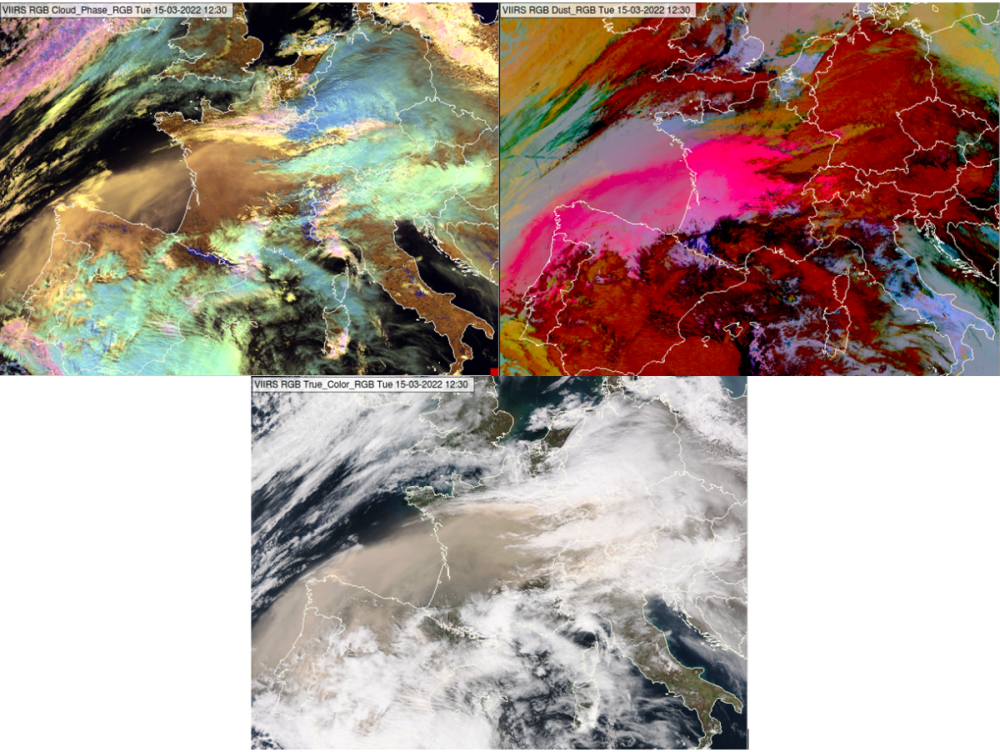
Fig. 1: VIIRS Cloud Phase, Dust and True Colour RGB images for 15 March 2022 12:30 UTC.
Figure 2 shows a thinner dust cloud over the Mediterranean Sea, around Corsica and Sardinia islands. It appears darker in the Cloud Phase RGB than in the previous case. Dust and True Colour RGBs confirm the presence of dust cloud.

Fig. 2: VIIRS Cloud Phase, Dust and True Colour RGB images for 10 August 2021, 11:08 UTC.
Figure 3 shows a dust cloud over the Ionian Sea. Dust cloud is seen along the frontal cloudiness and also between the clouds, see the arrows.

Figure 4 shows the Black Sea region. In the Dust RGB one can see a dust cloud in pink colour south of the Black Sea indicated by black arrows. In the True Colour RGB high aerosol content is seen over the southern regions of the sea. One can suspect the dust cloud over land in Turkey and maybe in Romania, see the yellow arrows. In the Cloud Phase RGB the dust cloud is not really recognizable. One might recognize it over the water in case you know already (based on the other two RGBs) that it is present.
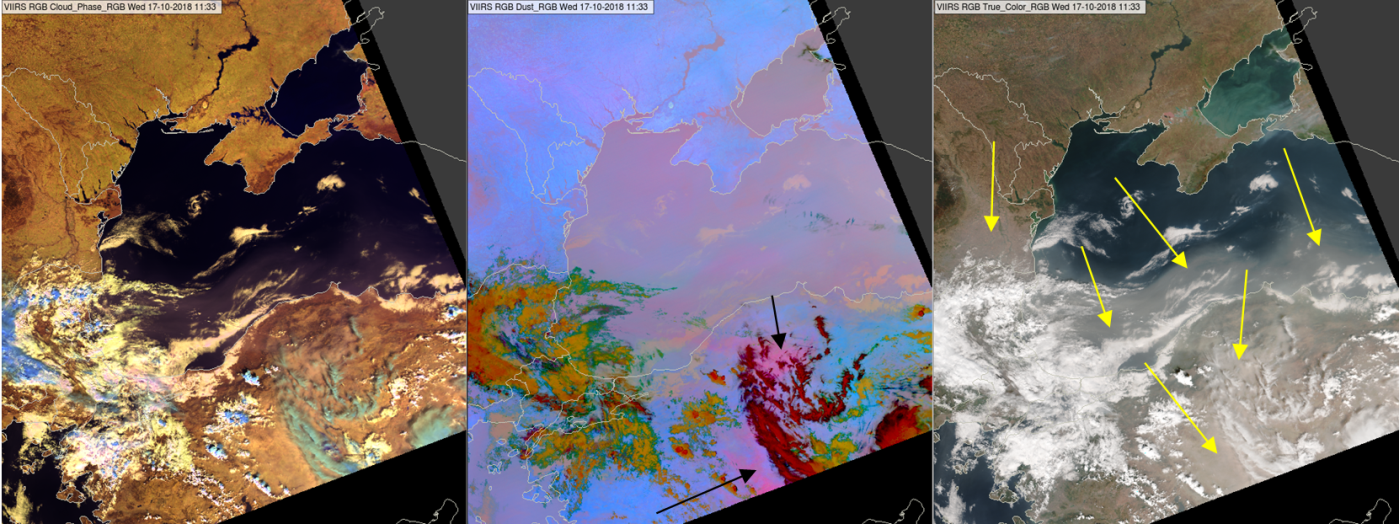
Fig. 4: VIIRS Cloud Phase, Dust and True Colour RGB images for 17 October 2018, 11:33 UTC.
Note that the actual colour shades depend on the sun-viewing geometry as well (solar and satellite directions). The reason is twofold:
• The scattering properties depends on the directions.
• Any semi-transparent cloud (ice cloud, dust cloud, aerosol plume) is thicker for a slant view.
Explanation of the colours of dust clouds in the Cloud Phase RGB (see the recipe):
For the semi-transparent dust cloud the colour shade depends not only on the dust cloud properties but also on the characteristics (colour) of the underlying surface.
Over sea the intensity of the signals depend on the transparency of the dust cloud. Usually the red signal is the strongest, while the blue signal is the weakest. For a very thin dust cloud it can happen that the green signal is the weakest.
Bare soils and deserts usually appear (reddish) brown or tan in the VIIRS True Colour RGB images. Colour shades depend on the soil/sand/rock type. Bare soils may appear darker brown. Sandy and rocky deserts are usually brighter than bare soils and appear in shades of brown, most often tan. The mountains in the Sahara are greyish brown. Australian deserts appear reddish brown.
The next image shows the Iberian Peninsula at the beginning of October. Large areas not covered by green vegetation appear brownish/tan.
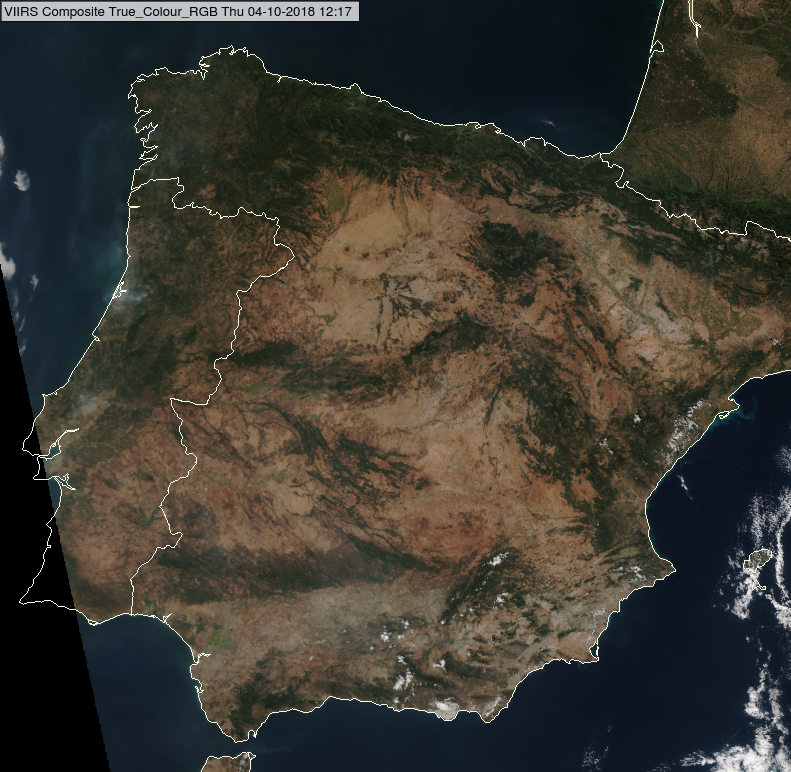
NPP, VIIRS True Colour RGB image for 04 October 2018, 12:17 UTC
The next image shows a part of Central Europe and the northern part of the Balkan Peninsula in February. Land, not covered by clouds or snow, appears (mostly dark) brownish. The reason for this are lowlands in these areas that lack the green vegetation in February; and the mountains with coniferous woods are not green in this image because of the snow cover.
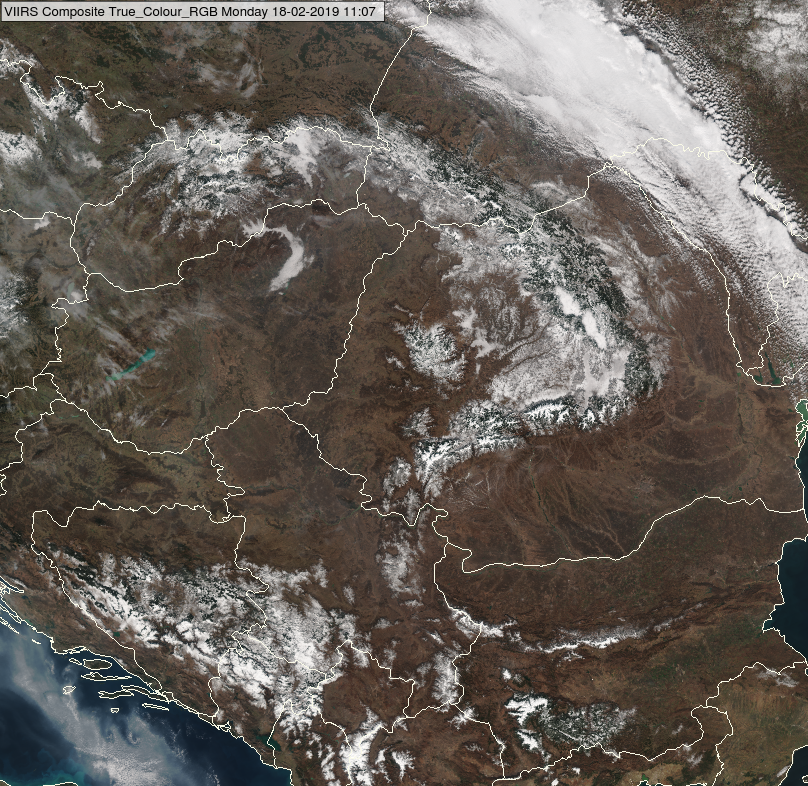
NPP, VIIRS True Colour RGB image for 18 February 2019, 11:07 UTC
Deserts appear in shades of brown. The next image shows the Taklamakan Desert in China. This is a sandy desert appearing tan in the True Colour RGB image.
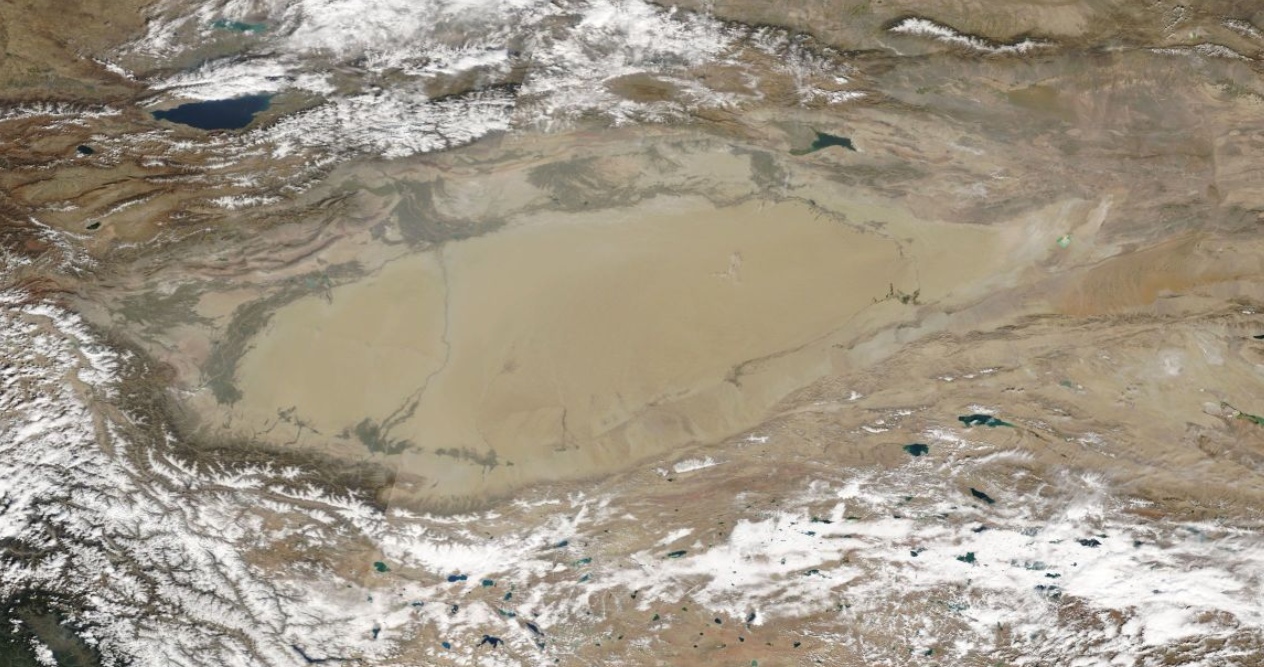
NPP, VIIRS True Colour RGB image of Taklamakan Desert, China, taken on 2 October, 2018
(Source: https://worldview.earthdata.nasa.gov)
The next image shows the Sahara and the Arabian Peninsula. The Sahara is mainly a rocky desert; some parts of the desert are sandy and there are (rocky) mountains as well. The Sahara appears in several colour shades: most of the area is tan, but mountains (rocks) appear greyish brown.
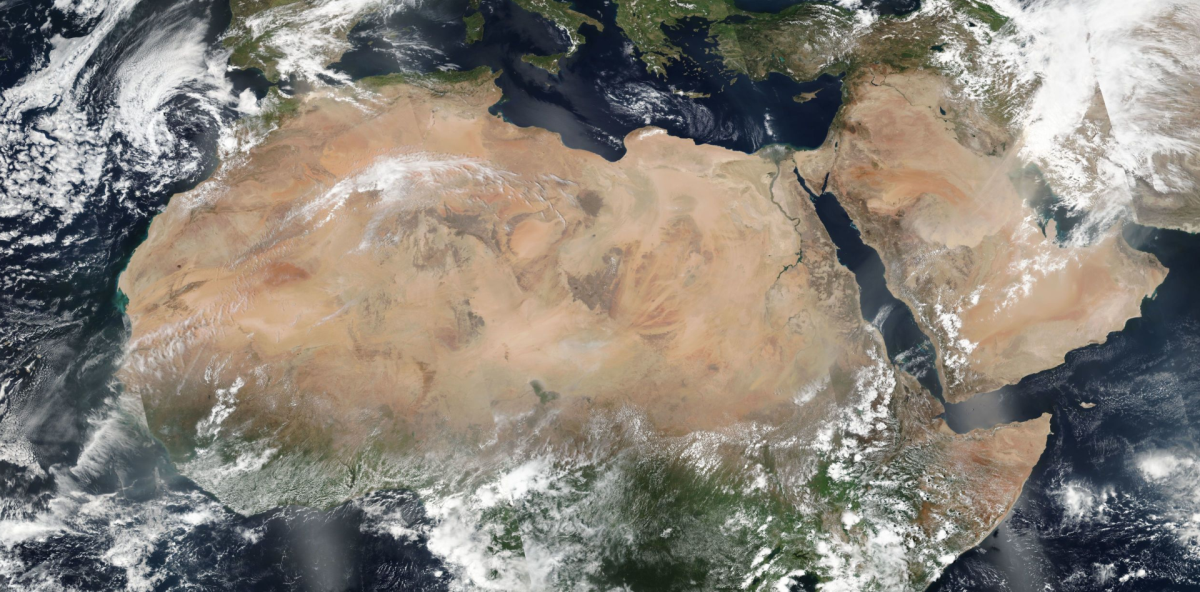
NPP, VIIRS True Colour RGB image for 23 April 2018, mosaic image composed from several overpasses (Source: https://worldview.earthdata.nasa.gov)
The Australian deserts are not completely devoid of vegetation, but have large areas with vegetation (very limited in height or extent). The majority of the Australian desert appears reddish brown (see the image below).

NPP, VIIRS True Colour RGB image for 14 May 2018, mosaic image composed from several overpasses (Source: https://worldview.earthdata.nasa.gov)
Note that the bare soil/desert reflectivity depends on the solar and satellite viewing directions as well. Towards the edge of the swath the colour brightness may vary (as an example, see the mosaic images above).
Explanation of the colour of bare soils and deserts in the True Colour RGB (see the recipe):
The reflectivity of bare soils is usually below 50% in all three channels of the True Colour RGB. It slightly increases with longer wavelength in the visible spectral range. That is why the bare soils appear brownish.
The reflectivity of sandy desert is more than 50% and slightly increases with longer wavelength in the visible spectral range. That is why it usually appears tan.
The majority of the Australian deserts appear reddish brown, the composition of the rocks is different, and additionally there is some green vegetation in these deserts which makes the colour shades slightly darker.
Pure volcanic ash clouds usually appear brownish or tan in the VIIRS True Colour RGB images. Very thin volcanic ash clouds may appear grey. If the ash plume is mixed with ice crystals (formed from water vapour originating from the volcano) than it may appear greyish. Volcanic SO2 gas is not seen in the True Colour RGB.
True Colour RGB images are ‘Rayleigh corrected’. This means the impact of Rayleigh scattering by the atmospheric molecules has been removed. This makes the images clearer. However, the impact of the aerosols’ scattering is not removed. This is one of the strengths of the True Colour RGB: it is quite sensitive to particulate matter in the atmosphere like smoke, smog, haze and dust.
The next two images show an eruption of the Italian Mount Etna captured by NPP and NOAA-20 on the same day with only half an hour difference. Two plumes are seen originating from Etna: a grey plume and a darker, brownish coloured one. The tan/brown plume is the volcanic ash. Volcanoes usually eject not only ash into atmosphere, but gases and water vapour as well. From the water vapour, ice clouds are forming. In the image below, one can see such a greyish cloud plume (likely a mixture of ice crystals and ash) along the southern edge of the brownish ash plume.
The image below shows a smoke plume over the Aegean Sea.
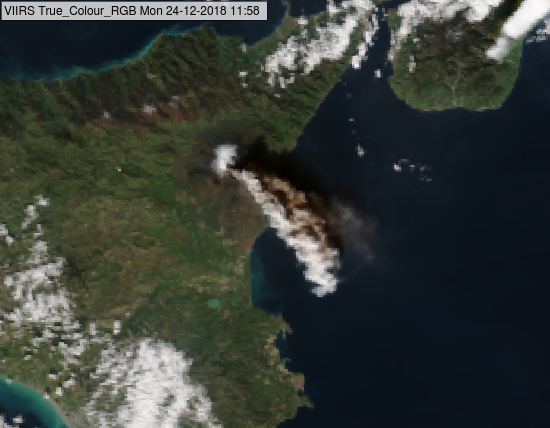
NPP, VIIRS True Colour RGB for 24 December 2018, 11:58 UTC
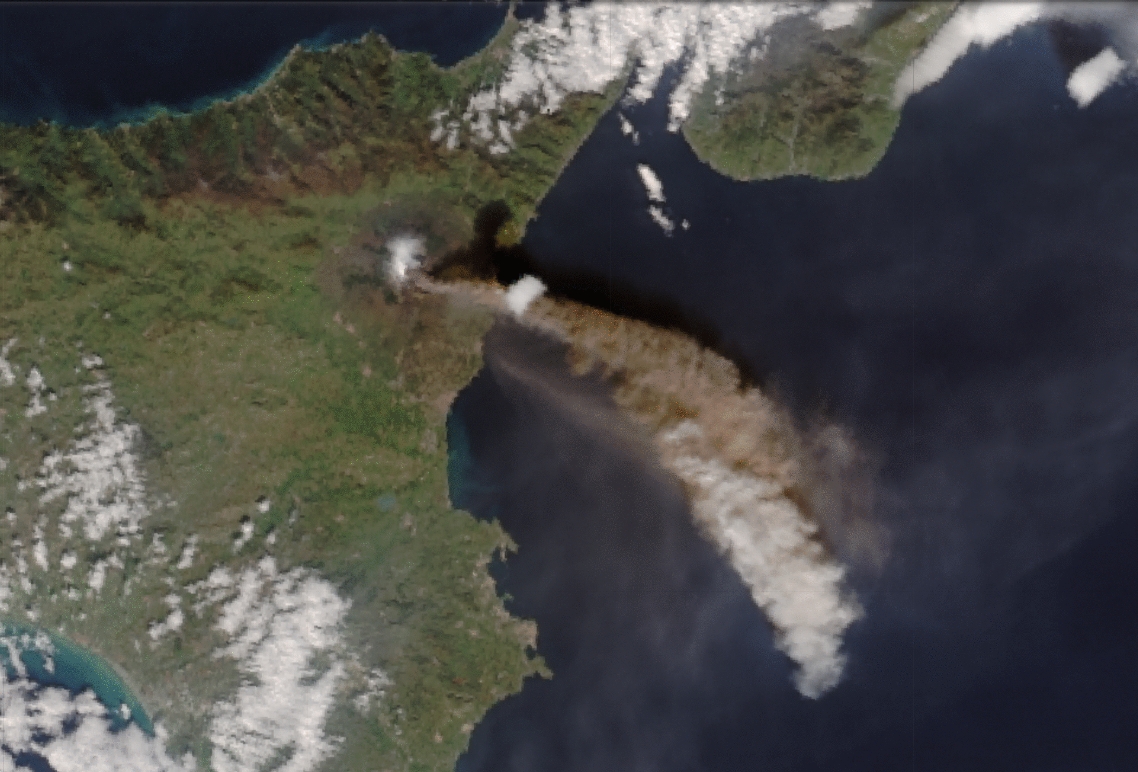
NOAA-20, VIIRS True Colour RGB for 24 December 2018, 12:20 UTC
(Source: https://cimss.ssec.wisc.edu/goes/blog/archives/category/volcanic-activity)
The next image shows the explosive eruption of the Fuego volcano in Guatemala (Central America). VIIRS acquired the image of the ash plume, after the ash (brown colour) had punched through a deck of clouds.

NPP, VIIRS True Colour RGB for 3 June 2018, 19:00 UTC
(Source: https://disasters.nasa.gov/mount-fuego-eruption-2018/viirs-and-omps-view-deadly-fuego-eruption)
The next image shows the eruption of the Pavlof Volcano in Alaska. The volcanic ash plume appears in brown hue.
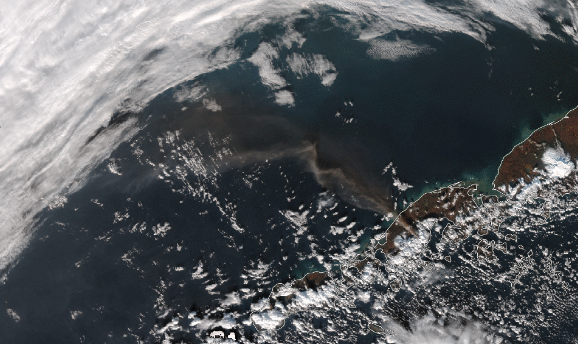
NPP, VIIRS True Colour RGB for 14 November 2014, 12:00 UTC
(Source: http://cimss.ssec.wisc.edu/goes/blog/archives/17179)
Note that:
• Pure volcanic ash clouds usually appear brownish or tan.
• Volcanic SO2 gas is not seen in the True Colour RGB.
• Thin volcanic ash clouds may appear greyish.
• If the ash plume is mixed with ice crystals (formed from water vapour originating from the volcano), it may appear greyish.
• Thick dust clouds usually appear also brownish grey, but its brownish shade is weaker.
• Other aerosol types appear mostly greyish. Pure biomass smoke tends to be bluish grey or grey, while haze appears grey.
• Towards the edge of the swath, a thin volcanic plume looks thicker, while along the sub-satellite track it looks thinner.
Explanation of the colour of volcanic ash clouds in the True Colour RGB imgages (see the recipe):
The aerosol particles scatter the visible radiation. The reflectivity of a thick aerosol plume depends on its concentration, the type of aerosols (its composition), the average particle size, the solar and satellite viewing angle and on the wavelength.
A thick volcanic ash cloud appears brownish or tan in the True Colour RGB, as its reflectivity is stronger at longer wavelengths.
In case of thin volcanic ash clouds, the measured radiance depends on the characteristics/reflectivity of the underlying surface as well. The satellite observes a combined signal:
• Radiation scattered by the dust particles into the direction of the satellite sensor and
• Radiation transmitted through the thin dust plume in the direction of the satellite sensor.
The weighting factor of the combination depends on the dust cloud transmissivity.



